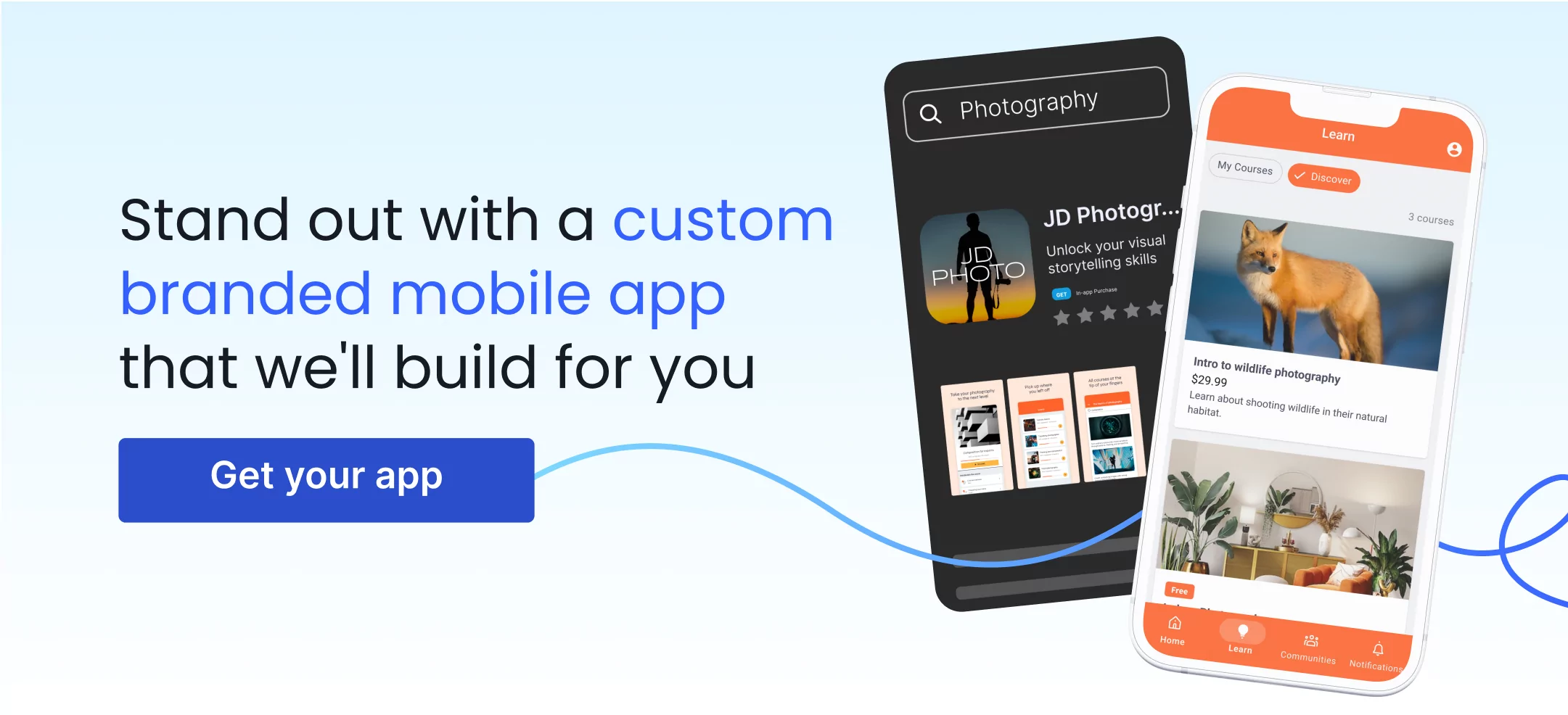Mobile learning is an increasingly popular learning method for people worldwide. It’s an excellent way for course creators to reach new audiences and meet students where they spend their time, on mobile technology.
The average Canadian checks their phone 144 times each day, while the average American checks their phone an insane 344 times per day.
As people continue to integrate technology into their daily routines, it’s no surprise that they’re turning to phones, tablets, and laptops to learn. Mobile learning gives students flexibility like they’ve never seen before as they explore new skills, hobbies, trades, and careers.
Let’s take a look at mobile learning’s advantages and disadvantages and explore how m learning can benefit your students.
Skip ahead:
- What is mobile learning (M-learning)?
- What are some mobile learning advantages?
- What are some disadvantages of mobile learning?
- Find the balance in mobile learning
What is mobile learning (M-learning)?
Mobile learning, or m-learning, refers to education that takes place on mobile devices. Mobile learning includes learning that takes place on mobile apps and web browsers. While mobile devices may include laptops, it generally refers to devices like smartphones and tablets.
What are some mobile learning advantages?
There are plenty of advantages to mobile learning, but we’ve compiled 6. They are accessibility, flexibility, motivation, current content, engagement, and affordability. Let’s explore each one a little more below:
Accessibility
One of the significant benefits of mobile learning is accessibility. M-learning courses are housed online, so students can access their courses from anywhere in the world. This makes mobile learning extremely versatile and can help creators reach a much wider audience.
Flexibility
Similar to accessibility but different, mobile learning gives students the flexibility that synchronous or in-person courses can’t. Students can complete the course at whatever time works best for them, whether they like to work at 12 noon or 12 midnight.
And, if the course allows, students can learn at their own pace. This offers them even more flexibility as they can take the course in as little as a few hours or as long as a few months.
Motivation
Both eLearning and mobile learning employ tech-savvy methods for teaching and assessment. Methods like interactive quizzes and tests can gamify the course and encourage students to make progress, engage with the material, and recall important points.
A motivated and engaged student is more likely to remember what they’ve learned and leave satisfied.
Current Content
Because mobile learning courses live online, they have the extraordinary advantage of revision. Creators can’t easily edit physical textbooks, in-person courses, and even webinars after they’ve been published. Online courses can.
Online course creators can take advantage of this and regularly update courses as needed. This will help them keep courses relevant and meaningful for students.
Engagement
M-learning can be an extremely engaging way for students to learn. Part of the magic behind creating engaging mobile courses is the microlearning approach you’ve probably seen or heard of already.
Duolingo has become the world’s most-used app for learning new languages by implementing engaging methods like microlearning. It gives students bite-sized lessons that are easy to complete on a regular basis.

Creators can also incorporate videos, games, and community to keep students engaged.
Affordability
Mobile learning courses typically don’t require in-person or synchronous instruction, and they aim to teach one skill or achieve one outcome. The scale of a mobile course can make it much more affordable than courses that require more staff, maintenance, scheduling, and research.
What are some disadvantages of mobile learning?
As with anything, there are disadvantages of mobile learning to consider as well. Mobile learning can leave students open to distraction, lack social interaction, rely on tech too much, lack personalization, and exclude students without access to good technology. Let’s explore each reason more below:
Distractions
One of the many benefits of mobile learning in education is that it requires students to access the material through a mobile device. However, this also means students are much more likely to become distracted.
Students will likely receive text messages, emails, and social media notifications during their lessons. These distractions can cause engagement and completion to drop.
Lack of social interaction
M-learning can encourage students to make meaningful connections online but doesn’t allow for meaningful in-person interactions.
While some students may thrive in a more isolated and self-paced environment, others may depend on social relationships to motivate them. This can become even more noticeable when students enroll in a course that requires long-term engagement.
Reliance on tech
M-learning, just like eLearning, is entirely reliant on technology. Creators must consider operating system compatibility and optimization for mobile devices or risk creating awkward and hard-to-use courses.
Reliance on tech can also exclude skills that rely on practical experience. For example, artists and mechanics may struggle with learning real-world skills without personal feedback and in-person instruction.
Poor personalization
Personalized feedback often comes from a 1-on-1 mentor, in-class instructor, or cohort leader. Despite engaging assessments like interactive quizzes and tests, students can still miss out on personalized feedback when they’re enrolled in mobile learning courses making it harder to learn and develop new skills.
Poor technology
While many students have access to up-to-date technology and reliable internet, not everyone does. Some students may be learning with older tech or have unreliable electricity and internet access.
Mobile learning does offer access to education for many, but it can still limit access to students without the necessary tools for online learning. You’ll have to consider your target audience and make sure to create a course that is accessible to them.
Find the balance in mobile learning
What is an advantage for some may be a disadvantage for others. For example, the extreme flexibility of a self-paced course might be demotivating for some audiences. Ultimately, it’s up to you to find the right balance for your target audience and create accordingly.
Regardless, creators can outweigh mobile learning disadvantages and make more accessible, high-quality, and inclusive courses than ever before. With the right content, you can utilize mobile technology to reach across the globe, engage students, and even build a community.
If you’re interested in creating an online course, try Branded Mobile by Thinkific! You’ll get your own white-labeled app for your courses and communities and additional selling tools like in-app purchases to help you drive more revenue.








